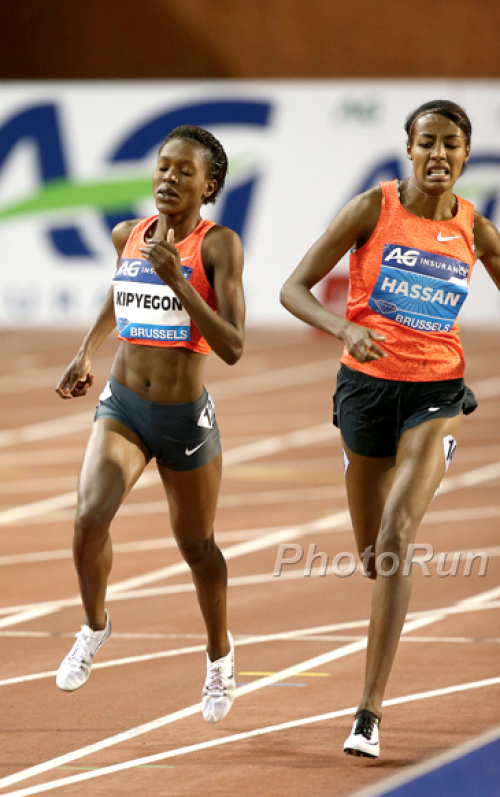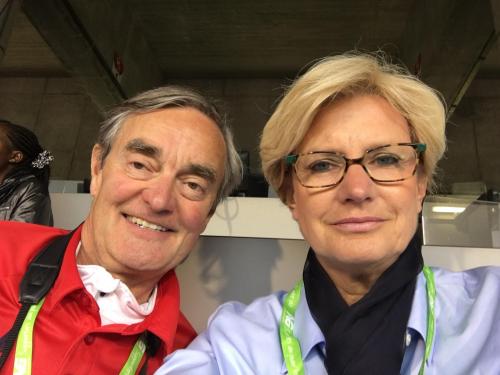 Faith Kipyegon vs. Sifan Hassan, 2015 Brussels, same battles, different year, photo by PhotoRun.net
Faith Kipyegon vs. Sifan Hassan, 2015 Brussels, same battles, different year, photo by PhotoRun.net
RunBlogRun opines: This is David Hunter’s piece on the Brussels DL and the challenges in covering such a meet in the modern era, when a power outage complicates those living in a digital age.
RelatedPosts
The power outage in Brussels could have taken away the amazing lustre of this end of season event, and the new approach to the DL final. But, while there was no light or power in the media room, journalists did it old school. The mixed zone become even more important and the athletes kept the energy up, as the crowds in the half lit stadium continued to enjoy the last Diamond league meeting of the season.
Here is David Hunter’s fine piece on the Memorial Van Damme, one of our favorite meets to cover each season.
We also include a photo from David Hunter and Margaret Hunter. Margaret travels to many of the meets and has put up with David and I doing track geek things at major events. Her photo skills have provided us with insights into major meetings around the world.
 David Hunter and Margaret Hunter, photo courtesy of Margaret Hunter, Brussels DL, pre outage
David Hunter and Margaret Hunter, photo courtesy of Margaret Hunter, Brussels DL, pre outage
This photo shows David Hunter and Margeret prior to the great Brussels power outage.
September 1st, 2017
Brussels, Belgium
Predicting how athletes will compete in the Diamond League finals is a difficult task indeed. World class track and field competitors plan their championship and Olympic years very carefully with an eye to cultivating their pinnacle performance at those global championships. And when important post-championship gatherings arrive at the end of a very long and hard-fought season, it is difficult for many to summon the physical and emotional energy to once again perform at their highest level.
Because of the calendar placement of AG Memorial Van Damme, the expectations for high quality performances at Brussels’ were guarded. The forecast for world list revising times and marks were further diminished when an early evening storm front moved through, forcing a temperature drop and bringing a steady rain that promoted pooling on areas of the track, jump runways and aprons, and throw rings. Conditions were further challenged when, just before the commencement of the Diamond League events, a massive power outage struck King Baudouin Stadium and its surrounding neighborhood. Not remedied until well after the meet’s conclusion, the electrical problem forced Brussel’s top brass to resort to meager emergency lighting. And while meet management handled this kerfuffle with skill and poise, the hearty near-capacity crowd remained festive, and the athletes took it all in stride, the backup illumination bathed the venue with only an inadequate, eerie, partial eclipse-like gloaming.
Despite these unwelcomed meteorological and electrical issues, the events here in Brussels were fiercely contested and often sensational. It is true that some marquee performers – Justin Gatlin, Wayde van Niekirk, Pierre Bosse, Omar McLeod, Tori Bowie, Phyllis Francis, Caster Semenya, and Sally Pearson, all of whom were crowned world champions less than 4 weeks ago – chose to conclude their seasons or otherwise bypass this the 2nd of two Diamond League finals. Yet a good number of the sport’s top athletes in attendance still had their “A” game going in Brussels even as the outdoor season was waning. In the women’s discus, the wet ring confounded many of the throwers as even the great Sandra Perković rattled one attempt into the cage. But the reigning Olympic and world champion regrouped and ultimately got the platter out 68.82m/225’9″ for an easy DL victory by nearly 3 meters.
With Olympic and world champion Omar McLeod not in the house, the men’s 110m hurdles was seen as a wide open affair. During the pre-race introductions, the 8 competitors could be seen nervously eyeing the standing water between the start line and the first flight of hurdles. Cautious starts helped avert any disasters, as Russia’s Sergey Shubenkov – always the exquisite technician – closed hard over the final barriers to take the win in 13.14. Spain’s Orlando Ortega [13.17] grabbed 2nd while Aries Merritt [13.20] – who set the current world record in this meet 5 years ago – finished 3rd.
All three medalists from last month’s world championships were on the line for the men’s 3000m steeplechase. Pre-race chatter suggested an assault on the 8 minute barrier was in the works. Early rabbiting set it up nicely as London’s bronze medalist Evan Jager took the bell at 7:02. Soufiane El Bakkali surged past Jager at the top of the backstretch, with Kenya’s Conseslus Kipruto promptly giving chase. Entering the homestretch, El Bakkali’s lead over the Kenyan looked sufficient to ensure him the win. But the Moroccan’s lackadaisical stretch run inspired Kipruto [8:04.73] to make one final surge allowing the reigning Olympic champion to catch El Bakkali [8:04.83] daydreaming right before the line for the win. After an ill-advised full hurdle attempt over the final water barrier resulted in a full baptismal for Jager, the American scrambled out of the water and the shadows and scampered past two competitors on the final straightaway to salvage 3rd as the London medalists duplicated their world championship 1-2-3 finish.
Mariya Lasitskene, displaying the form that won her world championship gold in London, easily captured the DL high jump title with a clearance of 2.02m/6’7½”. The Russian, who has the top 5 high jump marks this year, had several close misses at what would have been a world-leading 2.08m/6’9¾”.
Several of the rivalries that spiced last month’s world championships were once again renewed here in Brussels. In what was to be a carefully-rabbited women’s 1500m, the race cadence sagged after a spirited opening 400 meters in 61.80. World leader Sifan Hassan hit the bell with reigning Olympic and world champion Faith Kipyegon of Kenya close behind. The duo engaged in a sensational battle over the dimly-lit final 300 meters. The Kenyan’s final lap strength proved too much as she edged her Dutch foe, 3:57.04 to 3:57.22. American and world champion silver medalist Jenny Simpson finished 6th in a seasonal best of 4:00.70.
In the women’s 5000 meters, fellow East Africans competitors employed several mid-race challenges in an attempt to rattle world leader Hellen Obiri. No dice. Obiri – the world championship gold medalist – quickly tucked in behind the early pacesetter before ultimately setting sail on her own just before 2K crossed in 5:50. Obiri’s Kenyan teammates Beatrice Chepkoech, Margaret Kipkemboi, and Caroline Kipkirui went with her as did Ethiopian star Senbere Teferi. That talented quintet raced in a bunch until just after 4 kilos [11:37] when Kipkirui bolted into the lead. Gathering herself, Obiri boldly regained the lead from her teammate with 700 meters remaining as the twosome was now clear of the field. Obiri had a slight 1 meter lead at the bell, an advantage she enlarged over the final circuit which she covered in 63 seconds to cross the line first in 14:25.88. Chepkirui finished second in a PR 14:27.55.
With several cross rivalries woven into an impressive field, the women’s long jump was expected to be a multi-athlete battle. It was. Multiple lead changes took place throughout the rounds and after a drama-packed competition, only 9 centimeters separated the top 5 places. Serbia’s Ivana Å panović, a non-medalist in London, captured the DL Trophy with a winning 6th round leap of 6.70m/21’11¾” while Great Britain’s spunky Lorraine Ugen [6.65m/21’10”] finished 2nd. American Sha’Keela Saunders [6.64/21’9½”] grabbed 3rd to nip her teammate and world championship bronze medalist Tianna Bartoletta [6.63m/21’9″]. Reigning world indoor and outdoor long jump champion Brittney Reese [6.61m/21’8¼”] – looking fierce as always in her signature head scarf – was relegated to 5th.
Another rivalry was featured in the men’s triple jump as world champion medalists Christian Taylor and Will Claye squared off. After a couple of lead changes, Taylor’s 4th round effort of 17.49m/57’4¾” sealed yet another Diamond League crown for the WC gold medalist while Claye’s best leap of 17.35m/56’11¼” secured the runner-up position.
In a rivalry which could rage on for perhaps another decade, Olympic and world championship medalists Katerina Stefanidi and Sandi Morris locked horns once again in the women’s pole vault. Rio and London silver medalist Morris – who cleared the mythical 5.00 meter barrier here in last year’s gathering – jumped flawlessly in the early going and grabbed the lead when the Greek Olympic and world champion needed two attempts get over 4.75m. But Stefanidi’s 1st attempt clearance at 4.85/15’11” redirected the pressure back to Morris to match the Greek’s clearance on her initial attempt. Stefanidi clinched the crown when Morris couldn’t clear the new height on any of her three attempts.
Ah, but there also were hungry athletes here as well – those who performed weakly in last month’s IAAF championships or perhaps didn’t even qualify to compete in London. More than a few of those athletes, inspired by past disappointments and the robust prize money offered at the Memorial Van Damme, surprised here in Brussels as they sought to cap off their season on a high note and perhaps achieve an elevated year-end world ranking. The men’s shot – held the previous day at an outdoor inner-city venue which drew a curious and enthusiastic crowd – produced the first such hungry Diamond League champion. USA’s Darrell Hill – who arrived at the world championships as the #7 performer on the world list but could fare no better than 11th in London – finally put it all together in the streets of Brussels. His 6th round heave of 22.44m/73’7½” – a PR of nearly two feet – edged out Olympic gold medalist and record holder Ryan Crouser for the DL Trophy, moved the 24-year-old Hill up to #3 performer on the world list, and gave the young professional redemptive momentum heading into the off season.
Redemption was also the theme in both the women’s and men’s 100 meters. The absence of world champion Tori Bowie broadened opportunities for the talented field which nonetheless featured London silver medalist Marie Ta Lou, #2 2017 performer Michelle Ahye, and Olympic champion and world leader #1 Elaine Thompson. The Jamaican, still smarting from her disappointing 5th place finish in London, took advantage of this late season opportunity for vindication. While Ta Lou [10.93] generated her usual explosive start, her lead was short-lived as Thompson [10.92] closed with a vengeance to take the crown. Nigeria’s Blessing Okagbare [11.07] got up for 3rd. In the men’s dash, Jamaican Yohan Blake – now no longer in the shadow of his recently-retired legendary sprint teammate – captured perhaps his biggest 100m win since his 2011 world championship victory when he unfurled a good start, a better drive phase, and the race’s top close to win going away in 10.03. American veteran Mike Rodgers [10.09] reacted well to the gun and finished a clear 2nd.
Young American sprint star Noah Lyles – fully recovered from several nagging mid-season injuries which kept him off the U.S. world team – showed he too is hungry and offered a prelude of what we might witness in the coming year. Out on an island in Lane 9, the 20-year old raced the shadowy curve with poise and emerged out of the darkness to post an impressive 200 meter win in 20.00. In the process, the indoor world record holder at 300 meters took down wily American veteran Ameer Webb [20.01] and Turkey’s newly-minted world champion Ramil Guliyev [20.02].
Nigel Amos – the World Championship 800m favorite who finished 2nd in London – earned a measure of redemption by prevailing rather easily in the evening’s 800 meter race in 1:44.53. On the homestretch, Poland’s Adam Kszczot [1:44.84] was on his way to the runner-up spot, but his last-second protective glance to the inside allowed his countryman Marcin Lewandowski [1:44.77] to sneak by on the outside for 2nd.
Another unsuccessful world championship favorite Dalilah Muhammad [53.89] also showed better form in winning the women’s 400 meter hurdles. Although world champion Kori Carter was absent, Muhammad bettered the field with a strong stretch drive to clinch the victory while Czech star Zuzana Hejnová [53.93] finished 2nd.
In what was clearly the highest quality track event of the evening, Bahamian Shaunae Miller Uibo gained redemption for her homestretch melt down in last month’s world championship 400 meter final where she unexpectedly locked up in the final 30 meters to slide from gold to 5th. This time it was different. Poised and ready to respond to an expected challenge from Bahrain’s 19-year-old London silver medalist Salwa Eid Naser, the Olympic 400m champion was simply too strong on the homestretch as she lifted nicely over the final 80 meters to cross first in a world-leading 49.46 while the young Naser finished 2nd in 49.88 to set the new Bahraini national record. American’s Courtney Okolo [50.91] and Natasha Hastings[50.98] grabbed the next 2 places.
With the Brussels meet having determined the final 16 DL champions, the curtain has come down on the last truly pivotal track & field gathering of the year. And while a handful of smaller meets will finish off this outdoor season, now is the opportune time to reflect back on the activity just concluded and look ahead to next year. In 2017, among others, we likely said goodbye to Tyson Gay, Wallace Spearmon, Bershawn Jackson, and Nick Symmonds – each of whom has authored a memorable track career. We continue to marvel at the performances of apparently-ageless athletes such as Gatlin, Dawn Harper-Nelson, Kim Collins, Mo Farah, Veronica Campbell Brown, and Kerron Clement. We celebrate the emergence of new champions such as Francis, Kori Carter, Bosse, Emma Coburn, and Courtney Frerichs. We look forward to the redemptive comebacks by athletes who sustained injuries during the past year, such as Derek Drouin, Clayton Murphy, and Renaud Lavillenie. And we eagerly await even further progression of promising young stars such as Lyles, Devon Allen, the Ingebrigsten brothers, Vashti Cunningham, Naser, Ryan Crouser, Darrell Hill and others.
And although the important events of the past year are many and often difficult to accurately interpret, we nonetheless realize there are many reasons to view the upcoming non-championship year with hope and optimism. Track & field has always exhibited a buoyant resiliency that has served it well over a history that spans thousands of years. Through the restorative nature of its ever-changing participants, the simple purity of its events, and its ability to overcome threats to its success, track & field has continuously shown itself to be a compelling sport that has power – even on a late summer night when one of its celebrated host venues did not.
Author

Dave Hunter is an award-winning journalist who is a U.S. Correspondent for Track & Field News. He also writes a weekly column and serves as Senior Writer for www.RunBlogRun.com, and covers championship track & field competition domestically and in such global capitals as Moscow, Birmingham, Zurich, Brussels, Beijing, Rio de Janeiro, Zagreb, Ostrava, and Doha. Hunter frequently serves as the arena or stadium announcer for championship track & field gatherings, including the Ivy League, the Big East, the Mid-American Conference, the NAIA, the Big Ten, and the Millrose Games. Hunter has undertaken foreign and domestic broadcast assignments. He ran his marathon P.R. 2:31:40 on the Boston Marathon course back in the Paleozoic Era. To find out more about Dave, visit his website: www.trackandfieldhunter.com He can be reached at: dave@trackandfieldhunter.com
View all posts




















